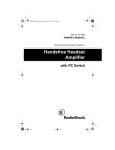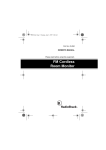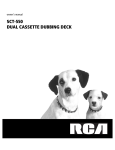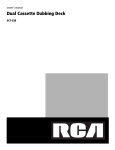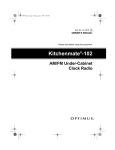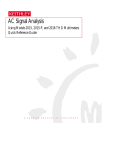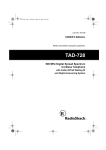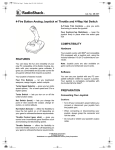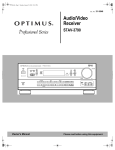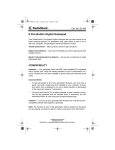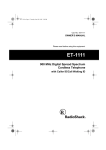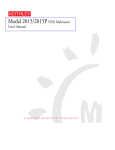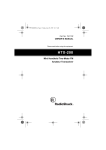Download Optimus - Katadyn Products Inc. SCT
Transcript
14-678.fm Page 1 Wednesday, June 2, 1999 9:29 AM Cat. No. 14-678 OWNER’S MANUAL Please read before using this equipment. SCT-540 Dual Cassette Dubbing Deck 14-678.fm Page 2 Wednesday, June 2, 1999 9:29 AM FEATURES Your Optimus SCT-540 Dual Cassette Dubbing Deck delivers superb stereo sound through your receiver/amplifier. The automatic tape selector system, combined with Dolby B NR, gives you superior stereo recording. Its features include: WARNING: To reduce the risk of fire or shock hazard, do not expose this product to rain or moisture. CAUTION RISK OF ELECTRIC SHOCK. DO NOT OPEN. Auto-Reverse Record and Playback — let you record and play both sides of a tape without turning it over. Feather-Touch Full-Logic Controls — let you quickly and quietly operate the cassette deck controls. CAUTION: TO REDUCE THE RISK OF ELECTRIC SHOCK, DO NOT REMOVE COVER OR BACK. NO USER-SERVICEABLE PARTS INSIDE. REFER SERVICING TO QUALIFIED PERSONNEL. This symbol is intended to alert you to the presence of uninsulated dangerous voltage within the product’s enclosure that might be of sufficient magnitude to constitute a risk of electric shock. Do not open the product’s case. High-Speed Dubbing — lets you accurately copy tapes at twice the normal speed. Variable Pitch Control — lets you control pitch during playback. Dolby B Noise Reduction — reduces tape hiss and noise for the best possible audio recording. Recording Level Meter — lets you control the recording quality. Tape Counter (DECK 2 Only) — lets you accurately track specific sections of a recording. Auto Search Music System (ASMS) — lets you quickly locate a selection. Auto Tape Selector — automatically adjusts equalization and bias to match the type of tape you use. For your permanent records, we suggest you record your cassette deck’s serial number in the space below. You can find the serial number on the label on the back panel of the cassette deck. Serial Number: ________________________________ Caution: Most material on prerecorded tapes is copyrighted. The unauthorized duplication of copyrighted material is a violation of the copyright laws of most countries and such duplication might result in fines and imprisonment. Note, however, in the United States, it is not a violation of U.S. copyright laws for a consumer to use an audio recording device to duplicate musical recordings for noncommercial (personal) use. ! This symbol is intended to inform you that important operating and maintenance instructions are included in the literature accompanying this product. CAUTION: Unplug the cassette deck's power cord when you will not use the cassette deck for extended periods. FCC NOTICE This system complies with the limits for a Class B digital device as specified in Part 15 of FCC Rules. These limits provide reasonable protection against radio and TV interference in a residential area. However, your equipment might cause TV or radio interference even when it is operating properly. To eliminate interference, you can try one or more of the following corrective measures: • Reorient or relocate the receiving antenna. • Increase the distance between the equipment and the radio or TV. • Use outlets on different electrical circuits for the equipment and the radio or TV. Consult your local RadioShack store if the problem still exists. Warning: Changes or modifications to this unit not expressly approved by RadioShack could void the user’s authority to operate the equipment. This cassette deck is made and tested to meet exacting safety standards. It meets both UL and FCC requirements. © 1999 Tandy Corporation. All Rights Reserved. RadioShack and Optimus are registered trademarks used by Tandy Corporation. 2 ! 14-678.fm Page 3 Wednesday, June 2, 1999 9:29 AM IMPORTANT SAFETY INSTRUCTIONS Careful attention is devoted to quality standards in the manufacture of your cassette deck, and safety is a major factor in its design. However, safety is also your responsibility. This section lists important information that will help you properly use and enjoy your cassette deck. Read all the included safety and operating instructions before using your cassette deck. Follow them closely, and retain them for future reference. Heed Warnings — Follow all warnings on the product and in the operating instructions. Cleaning — Unplug this product from the wall outlet before cleaning. Use only a damp cloth for cleaning. Do not use liquid or aerosol cleaners. Objects and Liquids — Never push objects of any kind into this product through openings, as they may touch dangerous voltage points or short out parts that could result in a fire or electric shock. Never spill liquid of any kind on the product. Servicing — Do not attempt to service this product yourself, as opening or removing covers may expose you to dangerous voltage or other hazards. Refer all servicing to qualified service personnel. Damage Requiring Service — Unplug this product from the wall outlet and refer servicing to qualified service personnel under the following conditions: • When the power-supply cord or plug is damaged. Attachments — Do not use attachments/accessories not recommended by the product manufacturer, as they might create a hazard. • If liquid has been spilled or objects have fallen into the product. Water and Moisture — Do not use this product near water (for example, near a bathtub, washbowl, kitchen sink, or laundry tub; in a wet basement; or near a swimming pool). • If the product does not operate normally by following the operating instructions. Adjust only those controls that are covered by the operating instructions, as an improper adjustment of other controls may result in damage and will often require extensive work by a qualified technician to restore the product to normal operation. Accessories — Do not place this product on an unstable cart, stand, tripod, bracket, or table. The product may fall, causing serious injury to a child or adult, and serious damage to the product. Use only with a cart, stand, tripod, bracket, or table recommended by the manufacturer or sold with the product. Follow the manufacturer's instructions for mounting, and use a recommended mounting accessory. Carts — Move the product on a cart carefully. Quick stops, excessive force, and uneven surfaces may cause the product/cart to overturn. Ventilation — Slots and openings in the cabinet provide ventilation, ensure reliable operation, and protect from overheating. Do not block or cover these openings, and do not place the product on a bed, sofa, rug, or other similar surface. Do not place the product in a built-in installation such as a bookcase or rack unless it provides proper ventilation as specified by the manufacturer. Power Sources — Operate this product using only the power source indicated on its marking label. If you are not sure of your home's power type, consult your product dealer or local power company. • If the product has been exposed to rain or water. • If the product has been dropped or damaged in any way. • When the product exhibits a distinct change in performance. Replacement Parts — When replacement parts are required, be sure the service technician uses replacement parts specified by the manufacturer or having the same characteristics as the original part. Unauthorized substitutions may result in fire, electric shock, or other hazards. Safety Check — Upon completion of service or repairs to this product, ask the service technician to perform safety checks to determine that the product is in proper operating condition. Wall or Ceiling Mount — The product should be mounted to a wall or ceiling only as recommended by the manufacturer. Heat — The product should be situated away from heat sources such as radiators, heat registers, stoves, or other products (including amplifiers) that produce heat. Non-use Periods — Unplug the cassette desk’s power cord when you will not use it for extended periods. Polarization — This product is equipped with a polarized AC line plug (a plug having one blade wider than the other). This plug will fit in the power outlet only one way. This is a safety feature. If you cannot insert the plug fully into the outlet, try reversing the plug. If the plug still doesn't fit, contact your electrician to replace your obsolete outlet. Do not defeat the safety purpose of the polarized plug. If you need an extension, use a polarized cord. Power-Cord Protection — Route power-supply cords so they are not likely to be walked on or pinched by items placed on or against them, paying particular attention to cords at plugs, convenience receptacles, and the point where they exit from the product. Lightning — For added protection for this product during a lightning storm, or when it is left unattended and unused for long periods of time, unplug it from the wall outlet and disconnect the antenna or cable system. This will prevent damage to the product due to lightning and power-line surges. Overloading — Do not overload wall outlets, extension cords, or integral convenience receptacles, as this can result in a risk of fire or electric shock. 3 14-678.fm Page 4 Wednesday, June 2, 1999 9:29 AM CONTENTS Preparation ................................................................................................................................................................... Connections ............................................................................................................................................................ Line Output Jacks ............................................................................................................................................. Line Input Jacks ................................................................................................................................................ AC Power Cord ................................................................................................................................................. 5 5 5 5 5 Controls and Functions .............................................................................................................................................. 6 Operation ...................................................................................................................................................................... 7 Automatic Search Music System ............................................................................................................................ 7 Using Continuous Play (DECK 1 to DECK 2) ......................................................................................................... 7 Recording a Cassette Tape ..................................................................................................................................... 7 Dubbing a Cassette Tape ........................................................................................................................................ 8 Changing a Cassette Tape in DECK 1 During Dubbing ................................................................................... 8 Auto Dubbing a Cassette Tape ............................................................................................................................... 8 Hi-Speed Dubbing a Cassette Tape ........................................................................................................................ 8 Care ........................................................................................................................................................................ 9 Tape Tips ................................................................................................................................................................. 9 Tape Selection .................................................................................................................................................. 9 Restoring Tape Tension and Sound Quality ..................................................................................................... 9 Erasing Tapes ................................................................................................................................................... 9 Preventing Accidental Erasure ......................................................................................................................... 9 Environment ................................................................................................................................................... 10 Cleaning the Tape-Handling Parts .................................................................................................................. 10 Troubleshooting .................................................................................................................................................... 10 Specifications ............................................................................................................................................................. 11 4 14-678.fm Page 5 Wednesday, June 2, 1999 9:29 AM PREPARATION READ THIS BEFORE OPERATING • Choose the installation location of your cassette deck carefully. Avoid placing it in direct sunlight or close to a source of heat. Also avoid locations subject to vibrations and excessive dust, heat, cold or moisture. • Do not open the cabinet as this might result in damage to the circuitry or electrical shock. If a foreign object should get into the set, contact your dealer. • When removing the power plug from the wall outlet, always pull directly on the plug, never yank the cord. • Do not attempt to clean the unit with chemical solvents as this might damage the finish. Use a clean, dry cloth. • Keep this manual in a safe place for future reference. CONNECTIONS Connect your cassette deck to your receiver or amplifier using the supplied audio cables. Line Output Jacks Using one of the audio cables, connect the cassette deck’s L and R LINE OUT jacks to the receiver or amplifier’s left and right tape input jacks. Line Input Jacks Using the other audio cable, connect the cassette deck’s LINE IN jacks to the receiver or amplifier’s tape output jack. Note: If you are not sure which receiver/amplifier jacks to use, refer to your receiver or amplifier’s owner’s manual. Amplifier LINE IN Cassette Deck OUT L R To AC Outlet AC Power Cord Plug the AC power cord into an AC wall socket. 5 14-678.fm Page 6 Wednesday, June 2, 1999 9:29 AM CONTROLS AND FUNCTIONS 5 3 9 7 11 L -00 -10 -5 0 +3 +6 R 14 1 13 15 2 6 4 1. POWER 2. PITCH CONTROL Volume 3. DECK 1 Cassette Lid and Holder 4. DUBBING with Indicator 10 8 HI-SPEED DUBBING with Indicator AUTO DUB with Indicator 5. DECK 2 Cassette Lid and Holder 6. REVERSE MODE Indicator 7. LEVEL METER 8. REVERSE MODE Selector 9. DECK 2 COUNTER 11. RESET — Resets DECK 2 COUNTER 12. DOLBY NR Indicator 13. Operation Panel Deck 1 14. REC LEVEL Control Volume PLAY STOP — ASMS — 15. Operation Panel Deck 2 PLAY STOP — ASMS — RECO RD R EC/ PAUSE 6 10. DOLBY NR 12 14-678.fm Page 7 Wednesday, June 2, 1999 9:29 AM OPERATION 1. To turn on the cassette deck, press POWER. 2. Gently press OPEN on the cassette door (DECK 1 DECK 2 or ) and load the cassette tape. 3. Press DOLBY NR and the indicator lights. Press DOLBY NR again to turn off this feature. 4. Press REVERSE MODE to select the desired reverse mode (Only DECK 2). The cassette deck plays or records one side of the tape and stops. The cassette deck plays or records both side of the tape and stops. Note: To play or record both sides, you must press PLAY ). (not PLAY The cassette deck plays endlessly. Note: During recording, the cassette deck automatically changes the setting and operates the same way as both-side play. 5. Press the PLAY button. The indicator lights and play begins. For forward play. For reverse play. USING CONTINUOUS PLAY (DECK 1 TO DECK 2) You can set the cassette deck to play one side of the tape in DECK 1, then automatically play the tape in DECK 2. To turn on the continuous play, press PLAY on DECK 1 for 3 or 4 seconds. DECK 1 starts playing and the PLAY indicator on DECK 2 flashes. When the cassette in DECK 1 finishes playing, the cassette tape in DECK 2 automatically begins playback. To cancel the continuous play, press STOP or any cassette button of the deck which is currently playing (either DECK 1 or 2). RECORDING A CASSETTE TAPE You can only record to a cassette in DECK 2. Select the source to record from on your receiver amplifier (CD, VCR, TUNER or DVD). 6. Adjust the tape speed by turning the pitch control. 1. Gently press OPEN on DECK 2 and insert the tape to be recorded into the cassette holder. 7. Press STOP to stop the tape. 2. Press DOLBY NR to use the noise-reduction system. 3. Select the desired reverse mode. AUTOMATIC SEARCH MUSIC SYSTEM The automatic search music system (ASMS) lets you quickly locate a desired selection on a cassette tape. It searches for the blank space before a selection and automatically stops just before playback begins. 1. Press PLAY to begin playing a tape. 2. To skip to the beginning of the current selection, press or — whichever points in the opposite direction of the play direction. To skip to the beginning of the next selection, press or — whichever points in the same direction as the play direction. • To record on one side only. • 4. Press To record on both sides. RECO RD R EC/ PAUSE . The RECORD indicator lights and both the PLAY direction indicators flash. 5. Turn REC LEVEL between MIN and MAX to adjust the recording level. 6. To select the direction for recording, press either PLAY or . ASMS might not operate as expected if: • The pause between selection is less than 4 seconds long. • The overall recorded volume level of a selection is very low. • The noise level between selections is very high. 7 14-678.fm Page 8 Wednesday, June 2, 1999 9:29 AM AUTO DUBBING A CASSETTE TAPE Notes: • If you want to record both sides of the cassette tape when the reverse mode switch is in , be . Otherwise, if you press PLAY sure to press PLAY , only side B of the cassette tape records. • When both sides of the tape finish recording, DECK 2 automatically stops. DUBBING A CASSETTE TAPE 1. Insert a prerecorded cassette tape into DECK 1, and a blank tape for recording into DECK 2 to dub a tape on one side. 2. Press DUBBING. The RECORD and DUBBING indicators light, and both PLAY direction indicators / of DECK 2 flash. 3. Press PLAY or to select the direction of the cassette tape for DECK 2. The indicators in the selected buttons stop blinking and the other indicators turn off. The indicator of DECK 1 lights up. 4. Press the STOP button on DECK 2 to stop dubbing. Both decks stop. Note: If the original tape was recorded using Dolby NR, the copy also has Dolby NR, regardless of the position of the DOLBY NR switch. If the tape you copy does not have Dolby NR, you cannot add it to the tape you record. Changing a Cassette Tape in DECK 1 During Dubbing If you press STOP on DECK 1 during dubbing, DECK 1 stops and DECK 2 records 4 seconds of blank tape then goes into the pause mode. During this time, you can change the cassette tape in DECK 1. Press RECO RD R EC/ then press the PLAY button of DECK 1 to PAUSE resume dubbing. 8 It is convenient to use this function when dubbing an entire cassette tape from the beginning. 1. Insert a prerecorded cassette tape into DECK 1 and a blank tape for recording into DECK 2. 2. Press AUTO DUB. The cassette tapes of DECK 1 and DECK 2 rewind automatically to the beginning after you press AUTO DUB. When rewinding is complete, Auto Dubbing begins. One side of a cassette tape is recorded from the beginning to the end automatically regardless of the mode. HI-SPEED DUBBING A CASSETTE TAPE 1. Insert a prerecorded cassette tape into DECK 1 and a blank tape for recording into DECK 2. 2. Press HI-SPEED. 3. Press DUBBING. 4. Press PLAY or to select the direction of the cassette tape for DECK 2. The indicators in the selected buttons stop blinking and the other indicators turn off. 5. Press STOP on DECK 2 to stop dubbing. Both decks stop. 14-678.fm Page 9 Wednesday, June 2, 1999 9:29 AM CARE To prevent the tape from being twisted: To enjoy your Optimus SCT-540 Dual Cassette Dubbing Deck for a long time: • Don’t pull the tape out of the upper opening of the cassette tape. • Keep the cassette deck dry. If it gets wet, wipe it dry immediately. • If the tape is wound loosely inside the cassette, use the tape deck on fast forward or reverse to tighten the tape. • Use and store the cassette deck only in normal temperature environments. • If a small portion of tape is unwound from the cassette, tighten the tape using a pencil. • Handle the cassette deck gently and carefully. Don’t drop it. Use a pencil to take up the slack and rotate it in the arrow direction. • Keep the cassette deck away from dust and dirt. • Wipe the cassette deck with a damp cloth occasionally to keep it looking new. Modifying or tampering with the cassette deck’s internal components can cause a malfunction and invalidate its warranty. If your cassette deck is not performing as it should, take it to your local RadioShack store for assistance. Erasing Tapes To record over a cassette tape, simply record as usual. The cassette deck records over the previous recording. You can quickly erase both sides of a cassette tape using a bulk tape eraser available at your local RadioShack store. TAPE TIPS Tape Selection For the automatic tape select function to work properly, metal and chrome (cobalt) tapes must have identification holes. Normal Tapes Chrome (Cobalt) Tapes Tape position identification holes. Restoring Tape Tension and Sound Quality After you play a cassette tape several times, the tape might become tightly wound on the reels. This can cause playback sound quality to deteriorate. To restore the sound quality, fast-forward the tape from the beginning to the end of one side, then completely rewind it. Then loosen the tape reels by gently tapping each side of the cassette’s outer shell on a flat surface. Note: If you use metal tape, the recorded sound might not be erased properly. Preventing Accidental Erasure Cassette tapes have two erase-protection tabs — one for each side. When a tab is in place, you can record on that side. To prevent accidental erasure of a tape recording, use a screwdriver to remove one or both of the cassette tape’s erase-protection tabs. This prevents REC from being pressed. If you later decide to record on a tape side after you have removed the erase-protection tab, place a piece of strong plastic tape over that side’s erase-protection hole. Be sure you cover only the hole originally covered by the erase-protection tab. Caution: Removing the erase-protection tabs does not prevent a bulk eraser from erasing a cassette tape. Caution: Be careful not to damage the cassette when tapping it. Do not touch the exposed tape or allow any sharp objects near the cassette. 9 14-678.fm Page 10 Wednesday, June 2, 1999 9:29 AM Environment TROUBLESHOOTING Avoid using the deck in the following conditions: If the cassette deck is not working as it should, the following suggestions might help. If you follow the suggestions in this chart and the cassette deck still does not work properly, contact your local RadioShack store for assistance. • In areas with high temperatures (near a heater, exposed to direct sunlight, for example.) • In areas with extremely low temperatures. • In areas where there is excessive humidity. • In a dusty atmosphere. • In areas where power line voltage fluctuations are severe (in which case the use of a voltage regulator may be advisable). Problem Probable Cause No sound while the tape is operating. Volume of stereo receiver/amplifier is set to “0.” Adjust the volume. Input function switch of amplifier is not set to TAPE. Set the input function switch to TAPE. Noise reduction switch is not in the correct position. Set the noise reduction switch to match the appropriate kind of recorded tape you are using. Cleaning the Tape-Handling Parts Dirt, dust or particles of the tape's coating can accumulate on the tape heads and other parts that the tape touches. This can greatly reduce the performance of the cassette player. After every 20 hours of tape player operation, follow these steps to clean the tape-handling parts or use a cassette deck cleaning kit (available at your local RadioShack store). 1. Remove the batteries and disconnect any other power source. 2. Open the cassette compartment door and press PLAY to expose the tape-handling parts. 3. Use a cotton swab dipped in denatured alcohol or tape head cleaning solution to clean the tape guides, record/play head, erase head, pinch roller, and capstan. 4. When you finish cleaning, press STOP/EJECT and close the cassette compartment door. Then reconnect power. 10 Strange tone quality or ragged sound. Suggestion REC cannot be Erase-protection operated. Cover the erasetabs are removed. prevention tab slots with adhesive tape. Low volume or Tape heads are dirty. weak sound with mute intervals. Clean the tape heads. Poor operation Mute recorded of skip function. length between two successive music selections is not longer than 4 seconds. Increase the mute length so that it is longer than 4 seconds or use a tape that has a mute length which is longer than 4 seconds. 14-678.fm Page 11 Wednesday, June 2, 1999 9:29 AM SPECIFICATIONS DECK 1 (only for playing) Track system ........................................................................................................................... 2 Track, 2-channel Stereo Tape Speed .............................................................................................................................................. 4.8 cm/second Motor ................................................................................................................................................................ DC Motor Frequency response: Normal Tape CrO2 Tape 40–12.5 kHz 40–12.5 kHz Fast Forward and Rewind Time ............................................................................................... 130 seconds (C-60 tape) DECK 2 (for recording/playing) Track system ........................................................................................................................... 4 Track, 2-channel Stereo Recording system ............................................................................................................................................... AC Bias Erasing System .............................................................................................................................................. AC Erasing Tape Speed .............................................................................................................................................. 4.8 cm/second Motor ................................................................................................................................................................ DC Motor Frequency response: Normal Tape CrO2 Tape 40–14 kHz 40–15 kHz Fast Forward and Rewind Time ............................................................................................... 130 seconds (C-60 tape) Wow and Flutter ................................................................................................................................. 0.2% (JIS, WRMS) Signal-to Noise Ratio (Dolby B NR Off) ............................................................................................. 55 dB (CCIRARM) Noise Reduction Effect (Dolby B NR On) ............................................................................................ 65 dB (CCIRARM) General Power Requirements ............................................................................................................................ 120 V AC, 60 Hz Power Consumption ................................................................................................................................................. 11 W Dimensions (W x H x D) ............................................................................................................... 16.5 × 5.7 × 13 Inches (420 × 146 × 330 mm) Weight (net) ...................................................................................................................................................... 10 lb. 1 oz 4.6 kg Specifications are typical; individual units might vary. Specifications are subject to change and improvement without notice. 11 14-678.fm Page 12 Wednesday, June 2, 1999 9:29 AM Limited One-Year Warranty This product is warranted by RadioShack against manufacturing defects in material and workmanship under normal use for one (1) year from the date of purchase from RadioShack company-owned stores and authorized RadioShack franchisees and dealers. EXCEPT AS PROVIDED HEREIN, RadioShack MAKES NO EXPRESS WARRANTIES AND ANY IMPLIED WARRANTIES, INCLUDING THOSE OF MERCHANTABILITY AND FITNESS FOR A PARTICULAR PURPOSE, ARE LIMITED IN DURATION TO THE DURATION OF THE WRITTEN LIMITED WARRANTIES CONTAINED HEREIN. EXCEPT AS PROVIDED HEREIN, RadioShack SHALL HAVE NO LIABILITY OR RESPONSIBILITY TO CUSTOMER OR ANY OTHER PERSON OR ENTITY WITH RESPECT TO ANY LIABILITY, LOSS OR DAMAGE CAUSED DIRECTLY OR INDIRECTLY BY USE OR PERFORMANCE OF THE PRODUCT OR ARISING OUT OF ANY BREACH OF THIS WARRANTY, INCLUDING, BUT NOT LIMITED TO, ANY DAMAGES RESULTING FROM INCONVENIENCE, LOSS OF TIME, DATA, PROPERTY, REVENUE, OR PROFIT OR ANY INDIRECT, SPECIAL, INCIDENTAL, OR CONSEQUENTIAL DAMAGES, EVEN IF RadioShack HAS BEEN ADVISED OF THE POSSIBILITY OF SUCH DAMAGES. Some states do not allow the limitations on how long an implied warranty lasts or the exclusion of incidental or consequential damages, so the above limitations or exclusions may not apply to you. In the event of a product defect during the warranty period, take the product and the RadioShack sales receipt as proof of purchase date to any RadioShack store. RadioShack will, at its option, unless otherwise provided by law: (a) correct the defect by product repair without charge for parts and labor; (b) replace the product with one of the same or similar design; or (c) refund the purchase price. All replaced parts and products, and products on which a refund is made, become the property of RadioShack. New or reconditioned parts and products may be used in the performance of warranty service. Repaired or replaced parts and products are warranted for the remainder of the original warranty period. You will be charged for repair or replacement of the product made after the expiration of the warranty period. This warranty does not cover: (a) damage or failure caused by or attributable to acts of God, abuse, accident, misuse, improper or abnormal usage, failure to follow instructions, improper installation or maintenance, alteration, lightning or other incidence of excess voltage or current; (b) any repairs other than those provided by a RadioShack Authorized Service Facility; (c) consumables such as fuses or batteries; (d) cosmetic damage; (e) transportation, shipping or insurance costs; or (f) costs of product removal, installation, set-up service adjustment or reinstallation. This warranty gives you specific legal rights, and you may also have other rights which vary from state to state. RadioShack Customer Relations, 200 Taylor Street, 6th Floor, Fort Worth, TX 76102 We Service What We Sell 04/99 RadioShack A Division of Tandy Corporation Fort Worth, Texas 76102 06A99 Printed in China












